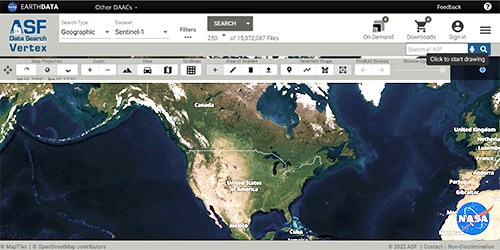Observational Products for End-Users from Remote Sensing Analysis (OPERA)
Table of contents
CSLC-S1: Product Specification Document, Static Product Specification Guide, Sample Product, and Interactive Guides
CSLC-S1 Product Specification Document
The CSLC-S1 Product Specification document describes the specifications of the OPERA Level-2 Coregistered Single-Look Complex (CSLC) product that uses Sentinel-1 SLC products as the primary image-based input. Accordingly, this data product is referred to by the short name CSLC-S1.
CSLC-S1-STATIC Product Specification Document
The CSLC-S1-Static Product Specification document describes the specifications of the OPERA Level-2 Radiometric Terrain-Corrected SAR Backscatter from Sentinel-1 (CSLC-S1) Static Layers (CSLC-S1-STATIC) product. It is distributed separately from the CSLC-S1 products, and it is only produced once (or a limited amount of times) for CSLC-S1 products characterized by the same burst identification string, i.e., for all the Sentinel-1 bursts covering the same geographical area on the ground. The CSLC-S1-STATIC contains both data raster layers (e.g., geocoded geometry layers) and product metadata.
CSLC-S1 Product Calibration/Validation (CalVal) Database
OPERA_CSLC_Calval_Database.zip: This file contains the calibration/validation (CalVal) database for the OPERA CSLC-S1 product. The CalVal database is a zip file that contains:
- Ancillary data products needed for validation, tables with CSLC-S1 product metadata (including links to the CSLC-S1 CalVal collections and static layers)
- Validation reports detailing the results of the validation process,
- A CalVal database reference document that details the contents of the database
This database is designed to be read and used by the OPERA CSLC CalVal GitHub repository to reproduce the validation process and results. Products can be downloaded by request.
CSLC_S1 Bursts
The burst database is an SQLite file generated by the OPERA ADT containing relevant information on the bursts acquired worldwide throughout the duration of the S1-A/B mission. Since the S1-A/B sensors perform systematic burst acquisitions, the burst geographical location on the ground is almost identical at each pass. Therefore, each burst can be identified by a unique alphanumeric string called a burst identification number or burst ID. The burst database includes the burst ID for all the bursts generated throughout the S1-A/B mission; each burst ID follows the same convention adopted by ESA in the generation of their burst map. The burst database includes other relevant processing information, such as the relative orbit number, the corner coordinates, and the projection system of the geographical grid, which generates each CSLC-S1 product.
Using the burst database while producing CSLC-S1 products guarantees that a time series of CSLC-S1 products characterized by the same burst ID shares the same geographical grid, i.e., they can be differenced pixel-wise. These products can be downloaded directly from an S3 bucket here.
The burst database is generated by the OPERA ADT and is available from the GitHub repository. The script inputs the ESA burst map (IW mode, in SpatiaLite format). The ESA burst map can be downloaded here.
Interactive Guides
- Visualization Guide — Illustrates how users can manipulate products in the open-source QGIS software
- Jupyter Notebook Tutorials — Introductory guides written in a Jupyter Notebook environment that showcases select applications
- Tutorial 1: How to generate interferograms (without having to download OPERA CSLC-S1 products locally). This example is for the Ridgecrest Earthquake, California, USA, from July 2019.
CSLC-NI: Product Specification Document, Static Product Specification Guide, Sample Product, and Interactive Guides
Note: NISAR is scheduled to be launched in 2025
RTC-S1: Product Specification Document, Static Product Specification Document, Sample Product, and Interactive Guides
RTC-S1 Product Specification Document
The RTC-S1 Product Specification document describes the specifications of the OPERA Level-2 Radiometric Terrain-Corrected (RTC) product that uses Sentinel-1 SLC data as the primary image-based input.
RTC-S1-STATIC Product Specification Document
The RTC-S1-Static Product Specification document describes the specifications of the OPERA Level-2 Radiometric Terrain-Corrected SAR Backscatter from Sentinel-1 (RTC-S1) Static Layers (RTC-S1-STATIC) product. The RTC-S1-STATIC product provides radar geometry layers, such as local incidence angle or incidence angle, that describe the Sentinel-1 acquisition geometry associated with the OPERA RTC-S1 products with the same burst ID.
RTC-S1 Product Calibration/Validation (CalVal) Database
OPERA_RTC_Calval_Database.zip: This file contains the calibration/validation (CalVal) database for the OPERA RTC-S1 product. The CalVal database is a zip file that contains:
- Ancillary data products needed for validation
- Tables with RTC-S1 product metadata (including links to the RTC-S1 CalVal collections and static layers)
- Validation reports detailing the results of the validation process
- A CalVal database reference document that details the contents of the database
This database is designed to be read and used by the OPERA RTC CalVal GitHub repository to reproduce the validation process and results. Products can be downloaded by request.
RTC-S1 Bursts
The SAS requires a burst database (SQLite file) for operations so that RTC-S1 products with the same bust IDs have the same map projection and geographic grid. The burst database is generated by the OPERA ADT and is available from the GitHub repository. Products can be downloaded directly from an S3 bucket here. The script inputs the ESA burst map (IWmode, in SpatiaLite format). The ESA burst map can be downloaded here.
Interactive Guides
- Jupyter Notebook Tutorials — Introductory guides written in a Jupyter Notebook environment that showcases select applications
- Tutorial 1: How to mosaic and visualize RTC-S1 images
- ASF StoryMap Tutorials
- OPERA Sentinel-1 RTC — Cloud-Optimized Access for Sentinel-1 Radiometric Terrain Corrected SAR Backscatter Products from OPERA
- This tutorial illustrates different ways to access and explore the RTC-S1 products, including workflows that allow you to interact with these cloud-optimized rasters directly in cloud storage without downloading them first
- Change Detection using OPERA Sentinel-1 RTC
- Change Detection workflow for OPERA Radiometric Terrain-Corrected products from Sentinel-1 (RTC-S1)
- OPERA Sentinel-1 RTC — Cloud-Optimized Access for Sentinel-1 Radiometric Terrain Corrected SAR Backscatter Products from OPERA
DISP-S1: Product Specification Document
DISP-S1 Product Specification Document
The DISP-S1 Product Specification document describes the specifications of the OPERA Level-3 Land-Surface Displacement (DISP) product from Sentinel-1 (S1). It is generated from a sequence of Level 2 CSLC products and is a high-quality InSAR-derived displacement product with reduced decorrelation noise using a hybrid Persistent Scatterer (PS) and Distributed Scatterer (DS) time series processing approach. The DISP-S1 product provides information on anthropogenic and natural changes on Earth’s surface, such as subsidence, tectonics, and landslides.
Note: The DISP-S1 product is scheduled to be available through ASF in early 2025.
DISP-NI: Product Specification Document, Static Product Specification Document, Sample Product, and Interactive Guides
Note: NISAR is scheduled to be launched in 2025
DISP-N1: Product Specification Document, Static Product Specification Document, Sample Product, and Interactive Guides
Note: NISAR is scheduled to be launched in 2025



